This New Omakase Restaurant in Manhattan Serves 22 Courses at a 10-seat Counter — and It Might Be the Best Meal I've Ever Had
- Oops!Something went wrong.Please try again later.
Lunch or dinner at Jōji in New York City's One Vanderbuilt gives guests a chance to watch a genius at work — and taste his exquisite sushi.
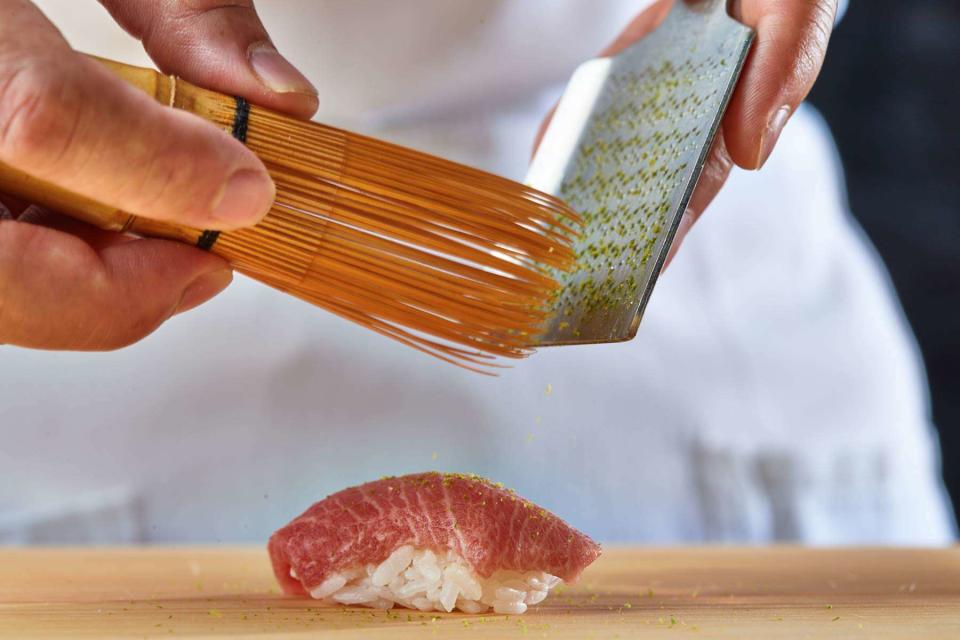
Thomas Images
Chef George Ruan produces a yanagi knife, long, elegant, and heavy, then effortlessly slices the flesh arranged in front of him — in this case, the delicate belly of a bluefin.
A masked youth appears with what looks like a medieval brigand’s blade, one end glowing like a poker. He lays it ceremonially across the upturned, pale flesh for searing, and smoke billows up to the lights. When the air clears, the youth is gone and Ruan is zesting the tiniest flakes of lime on what looks like a single teardrop of soy. With a brisk nod, he lays the piece of fish before me. It sits there, on display like a piece of Coronado’s gold.
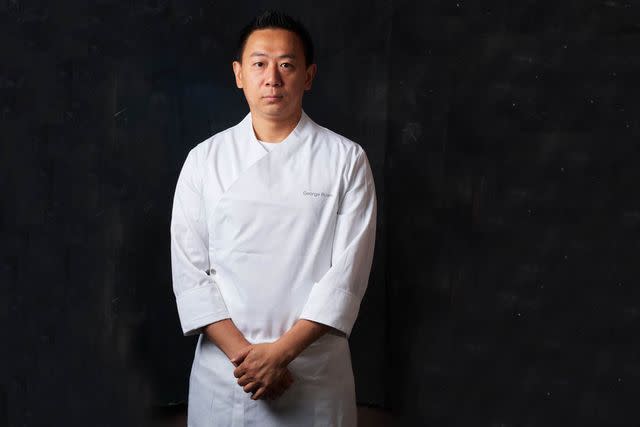
Courtesy of Jōji
“Hands,” he says to me, smiling at the chopsticks I’ve awkwardly picked up. “Hands all the way.”
I grab the fish with two fingers, drop it in my mouth, and shut my eyes as the flavors lay siege — subtle but also butter-rich, as the bite slowly dissolves on my tongue. It is quite possibly the most delicious thing I’ve ever eaten. I realize I’m making the same dumbstruck face you make after witnessing a really good card trick.
Amazing, chef.
He nods. He knows. And then he goes back to work.
Just off the 43rd Street entrance of glass skyscraper One Vanderbilt, tucked beneath a marble staircase that's just steps from tracks 36 to 42 of Grand Central Station, sits an alcove of volcanic stone and bonsai. This is the entryway to Jōji, chef George’s new omakase sushi restaurant set up in the classic style — 10 seats, two chefs, 22 courses. Guests perch on the edge of a pristine kitchen. Your chef is warmly fraternal, welcoming you to sit, then working a mere arm’s length away, in order to better to gauge individual reactions to the careful, immaculate pieces delivered out one at a time. I am given bluefin, white shrimp, sweet shrimp, seared toro, horse mackerel, striped jackfish, and a bit of sea eel, lightly crisped. I lose count of the offerings. Each one is hand-formed and delicately constructed, yet still the sort of bite you’d brazenly order 15 more of. Two of the sushi courses involve caviar, and each time the caviar comes in generous heaps. I down them in disbelief, feeling like a tsarina.
As the meal proceeds, Ruan guides me — per my asking — through the gist of Jōji’s creative philosophy, and what makes the team he’s assembled distinctive. He also speaks to the mystery around what goes on in a master sushi chef’s mind when fashioning what he hopes are perfect pieces.
“A lot of the time, high-end omakase chefs are trying to age the fish, to bring the flavor out.” He cocks his head to the side, like an appraiser. “That tuna, it’s a very delicate piece. We don’t want to overdo it.”
Ruan grew up in China, on a tiny island where seafood was abundant. The freshness, the feeling of catches being pulled mere moments ago from the deepest part of the ocean, remains palpable here in this subterranean eatery on the edge of New York’s most fabled train station. “We only age two things here. Everything else, the fresher the better. We break it down, we clean it. We marinate the tuna and that’s about it. The great thing about seafood is that it’s so clean, so pure. It’s what nature gives us.”
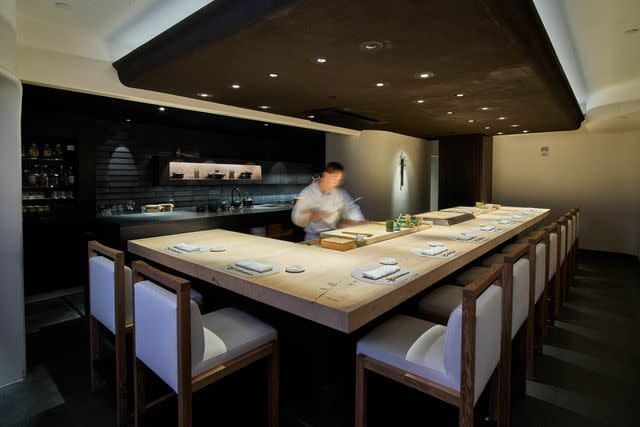
Bill Milne
A few seats down from me, a couple makes a familiar, amazed groan at the miraculously delicate richness of a piece of bluefin, a clean and pure sample of what nature has given us. Tuna? That was tuna? Like in its natural state?
“That’s the philosophy,” the chef says.
This deliberate dining experience makes me think back to 2011, when everyone suddenly discovered they were eating sushi wrong after watching a beloved documentary on the subject. Prior to that, dedicated eaters tended to love sushi the way we loved pizza — with our own fetishized preferences, usually favoring the bulky and quirky, overstuffed kitchen-sink-style rolls grabbed from a neighborhood take-out spot. Omakase was not widely known yet, but it has since become standard. And its central ethos is crucial to the experience: give up your prejudices and entrust yourself instead to the talents of the craftsman-creator in front of you, much like how you would trust a yogi, in an atmosphere of refined intimacy. Here sits a handful of guests gathered together, saying “omakase” — essentially, "up to you, chef."
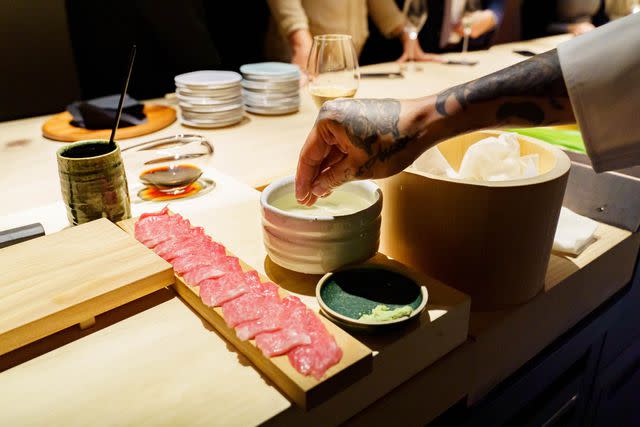
Eric Vitale
Of course, part of the credit for chef George’s new venture goes to his longtime mentor, legendary sushi chef Masa Takayama. Chef George learned from the master at his namesake restaurant in the Time Warner building.
“Detail,” chef George says about his education under Takayama. “He cared about every little detail. Like our shellfish that we serve here at Jōji, the brush will not touch the fish. Just a drip, drip, drip. That’s in case someone has an allergy to shellfish, and we don’t want to use the same brush.” That level of thought was “ingrained” in every person lucky enough to apprentice under chef Masa. And the master’s precise eye saw something 16 years ago in the younger Ruan, wide-eyed and working his first job as a server. (“I didn’t know shit,” he says, smiling.) Given enough time, Ruan absorbed more than a few priceless lessons in the art of being a particular kind of creator. With Chef Masa’s encouragement, Ruan soon took a gamble, moving from server to chef, from the front of the house to the back. His hours were grueling and the pay was worse, but there, as an apprentice to one of the world’s undisputed greats, he saw a future taking shape, one where painstaking study and attention to detail yielded greater rewards. He stayed on for years. He married and became a father. Then COVID-19 happened.
“After COVID, when we went back [to Masa], it wasn’t the same. A lot of the management didn’t come back, some of the chefs didn’t come back.” He shakes his head. “And then, having a kid made me realize, maybe it’s time to do something different.”
Ruan began freelancing, catering for people who had become Masa regulars, doing pop-ups, taking his yanagi knife into people’s homes to create omakase on demand. Word got around. By a stroke of luck, one of the executives at One Vanderbilt was a guest at one of those dinners. He was also a friend of fellow chef Daniel Boulud (whose latest restaurant, Le Pavilion, is housed in the same building). One thing led to another, and the idea for Jōji — “George” in Japanese — took shape. Ruan, along with partners chef Xiao Lin and chef Wayne Cheng, opened their new venture the following year, in a truly unique quarter of bustling midtown, under a staircase, as if set aside for pilgrims bent on reaching a fabled destination. It’s a site that could conceivably turn out to be a kind of New York City landmark; Jōji’s underground vibe is certainly part of its charm.
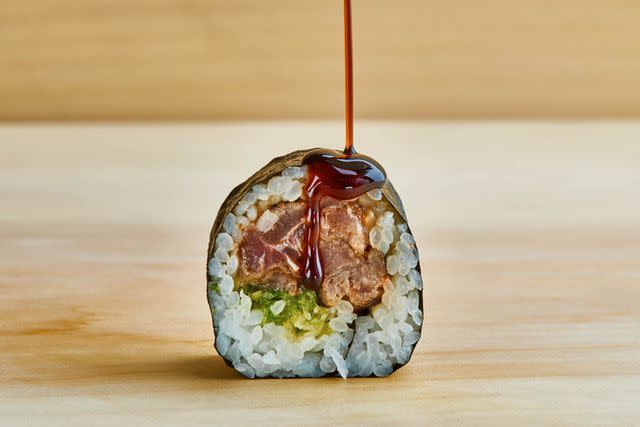
Thomas Images
“When we started talking about how we wanted this place to be, it was about people having a good time, and coming back. Repeat customers. That to me is more important than anything else.” And after barely one season at full operation, chef George says that people are indeed coming back. "We’ve had one guy here 12 times in four months.”
During my own visit, dessert is set in front of me: a slice of musk-melon. I’ve never heard of musk-melon before, and after one bite, I feel immensely poorer for it. Lunch service is ending. I linger in the afterglow of the meal like a guest who’s planning to overstay his welcome, slowly finishing my cup of sencha, ordering a chilled digestif of Kuheji Eau de Desir saké.
Before he packs up his knife, chef George invites me back for dinner. There are subtle differences between the services, he explains, that are worth exploring. That too, I realize, is part of the core Jōji philosophy. If anyone has dined with them before, and the teams know that, chef George and the others will change the menu based on your last visit. It’s one more method of making guests feel like travelers who've landed at the right station, midway through a journey. “We remember. People come back, and they have a different experience every time," he tells me.
For more Travel & Leisure news, make sure to sign up for our newsletter!
Read the original article on Travel & Leisure.

